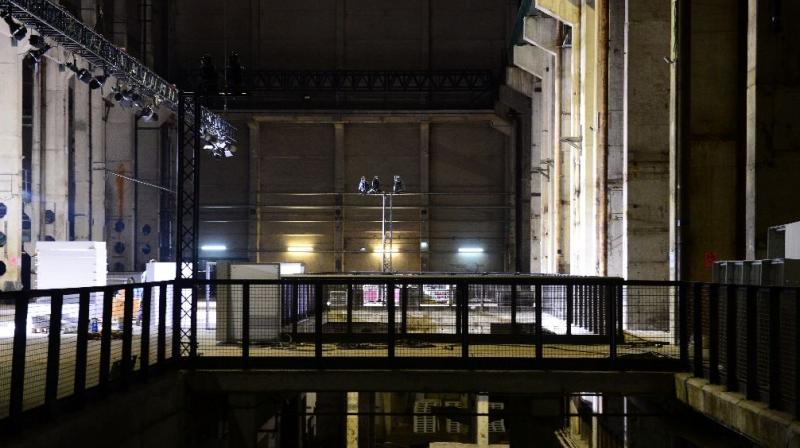Berlin, the cash-strapped capital of Europe’s top economy, has long tried to turn alternative culture into gold, but ambitious new bids to present underground art in museum settings could break new ground.
Street art and techno music took root across the city in the hothouse environment of post-Wall Berlin, drawing young creative types from around the world with cheap rents and disused industrial spaces ripe for the taking.
But as the city’s trademark brand of gritty coolness became globally renowned and then gradually more mainstream, Berlin has tried to capture lightning in a bottle: capitalising on the best of its art and nightlife scene without losing the spark that made it so unique in the first place.
A prime example of that high-wire act is the legendary nightclub Tresor.
A former underground safe room for a pre-war department store that later languished in the Wall’s no-man’s land, Tresor in 1991 quickly became the top dance club in Berlin’s budding techno scene.
Now celebrating its 25th birthday, it still attracts an international crowd of electronic music fans but has long since been supplanted by younger rivals such as Berghain, a hedonist temple frequently named the world’s best club.
However Tresor’s founder Dmitri Hegemann, 60, is ready to take his project to the next level with a museum dedicated to techno housed in the disused power station where the club moved in 2007.
He says such spontaneity and knack for reinvention have served Berlin well.
“None of the plans laid for the future of the city after the fall of the Wall worked out,” Hegemann said.
“An ‘economy of niches’ ended up in its place: open a club or a gallery, a restaurant, a bar, etc. That economy of niches dictated what to do next, and it’s what has made Berlin so attractive.”
‘Techno was the impetus’
Hegemann noted that there were 30 million overnight stays in Berlin last year and he estimates that “50 to 60 percent” of the visitors were attracted by subculture.
“Today 80 percent of our clientele doesn’t speak German. But what all these people have in common is that they have been marked by this ‘culture of renewal’ that took shape here, which became a movement and has transformed Berlin up until today.”
Hegemann, for his part, says “techno was the impetus” for all that upheaval and ferment.
Meanwhile Berlin’s prolific street artists have long gone from being spray-can wielding outlaws to an accepted and even treasured part of the Berlin cityscape.
Perhaps the ultimate example is the Wall itself, which for those on the free, western side became a giant canvas for graffiti, angry political slogans and yes, museum-quality art.
The longest remaining stretch, the East Side Gallery, attracts smartphone-wielding crowds with its murals which were painted in 1990 and recently restored.
Abandoned lots, often the remains of residential buildings bombed out during World War II, also provide walls for artist murals although rapid gentrification is quickly eating up such spaces.
Enter the Urban Nation foundation run by former gallery owner Yasha Young, who at the end of May launched work on a museum devoted to “contemporary urban art” set to open next year.
Young, like Hegemann, is aware that showcasing alternative culture in a museum runs the risk of sapping some of its vitality but says it is one worth taking.
“I’m not trying to press the planet ‘street art’ through a keyhole into a house that would be defying the purpose,” she said.
“It’s named a museum because it will also do what a museum does: collect, research, archive and support (artists).”
‘Delirious and mad’
The project will include an interactive library and vast exhibition spaces along the Buelowstrasse, a traffic-clogged avenue running through an unfashionable stretch of western Berlin.
The complex also plans to have a cafe, artist residences and studio space.
“We hope that this will be an art mile and it will become a truly living hub,” she said, adding that she plans to make the museum free to the public.
The city government, which provided the property, is enthusiastic about Young’s vision.
“The project is delirious and mad at the same time which is why it’s perfect for Berlin,” the city’s top culture official, Tim Renner, said.
Hegemann is also a bit ambivalent about calling his techno treasure trove a museum, which he says conjures images of “something that belongs to the past”. He prefers the term “Living Archives of Techno”.
So what will it look like? Hegemann said he of course wants to tell visitors about what techno is, how its influence spread, but also to “convey the feeling” to those who missed out on those heady days in dank Berlin cellars throbbing with bodies and music.
“I think of a place where visitors will come inside: suddenly, it gets dark, the fog machine gets going, a DJ appears in the distance, a bar rises up from the ground, the bass resonates and then the party’s started. A museum of the senses for those who don’t go to the club.”
Source: AFP











